
North Africa is a region encompassing the northern portion of the African continent. There is no singularly accepted scope for the region, and it is sometimes defined as stretching from the Atlantic shores of Mauritania in the west, to Egypt's Suez Canal and the Red Sea in the east. Others have limited it to the countries of Algeria, Libya, Morocco, and Tunisia, a region that was known by the French during colonial times as "Afrique du Nord" and is known by Arabs as the Maghreb. The most commonly accepted definition includes Morocco, Algeria, Tunisia, Libya, Egypt, and Sudan, the 6 countries that shape the top North of the African continent. Meanwhile, "North Africa", particularly when used in the term Middle East and North Africa (MENA), often refers only to the countries of the Maghreb.
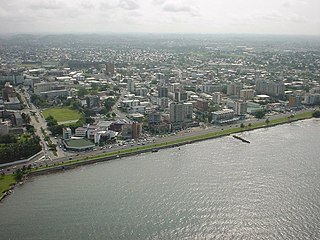
Libreville is the capital and largest city of Gabon. Occupying 65 square kilometres (25 sq mi) in the northwestern province of Estuaire, Libreville is a port on the Komo River, near the Gulf of Guinea. As of the 2013 census, its population was 703,904.

In classical antiquity, the cornucopia, also called the horn of plenty, was a symbol of abundance and nourishment, commonly a large horn-shaped container overflowing with produce, flowers, or nuts.

Olinda is a historic city in the Brazilian state of Pernambuco, located on the country's northeastern Atlantic Ocean coast, in Greater Recife. It has a population of 389,494 people, covers 41.681 square kilometres (16.093 sq mi), and has a population of 9,437 inhabitants per square kilometer. It is noted as one of the best-preserved colonial cities in Brazil.
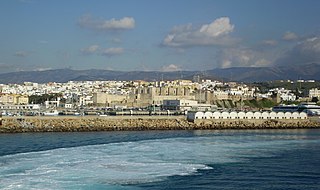
Tarifa is a Spanish municipality in the province of Cádiz, Andalusia. Located at the southernmost end of the Iberian Peninsula, it is primarily known as one of the world's most popular destinations for windsports. Tarifa lies on the Costa de la Luz and across the Strait of Gibraltar facing Morocco.
In the Catholic Church, a titular church is a church in Rome that is assigned to a member of the clergy who is created a cardinal. These are Catholic churches in the city, under the Diocese of Rome, that serve as honorary designations symbolising the relationship of cardinals to the pope, the bishop of Rome. According to the Code of Canon Law, a cardinal may assist his titular church through counsel or through patronage, although "he has no power of governance over it, and he should not for any reason interfere in matters concerning the administration of its good, or its discipline, or the service of the church".

The Basilica of Santa Maria in Trastevere ; English: Our Lady in Trastevere) is a titular minor basilica in the Trastevere district of Rome, and one of the oldest churches of Rome. The basic floor plan and wall structure of the church date back to the 340s, and much of the structure to 1140-43. The first sanctuary was built in 221 and 227 by Pope Callixtus I and later completed by Pope Julius I. The church has large areas of important mosaics from the late 13th century by Pietro Cavallini.

Santi Quattro Coronati is an ancient basilica in Rome, Italy. The church dates back to the 4th century, and is devoted to four anonymous saints and martyrs. The complex of the basilica with its two courtyards, the fortified Cardinal Palace with the Saint Silvester Chapel, and the monastery with its cosmatesque cloister is built in a silent and green part of Rome, between the Colosseum and San Giovanni in Laterano, in an out-of-time setting.
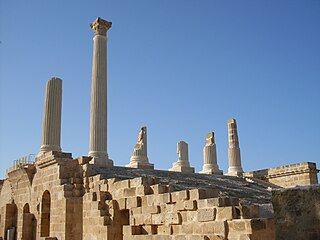
Uthina or Oudna was an ancient Roman-Berber city located near Tunis, Tunisia.

The Catholic Church in Tunisia is part of the worldwide Catholic Church, under the spiritual leadership of the Pope in Rome.

Castlecary is a small historic village in North Lanarkshire, Scotland, directly adjacent to the border with Falkirk. It has long been associated with infrastructure, being adjacent to a bridged river, a Roman fort and roads, a nationwide canal, a Victorian railway viaduct, and a modern motorway. Castlecary is close to the town of Cumbernauld but like Dullatur and Luggiebank is not officially part of the town. Around 1725, the barony of Castlecary, with a population of just seventeen families, was disjoined from the parish of Falkirk, and annexed to Cumbernauld quoad sacra. Castlecary is also near Allandale which, though in the Falkirk council area, was built for Castlecary fireclay workers.
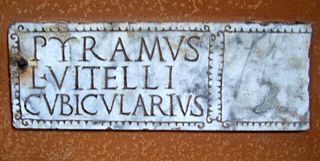
Titulus is a term used for the labels or captions naming figures or subjects in art, which were commonly added in classical and medieval art, and remain conventional in Eastern Orthodox icons. In particular the term describes the conventional inscriptions on stone that listed the honours of an individual or that identified boundaries in the Roman Empire. A titulus pictus is a merchant's mark or other commercial inscription.

Vindobala was a Roman fort at the modern-day hamlet of Rudchester, Northumberland. It was the fourth fort on Hadrian's Wall, after Segedunum (Wallsend), Pons Aelius (Newcastle) and Condercum (Benwell). It was situated about 11 kilometres (6.8 mi) to the west of Condercum. The name Vindobala means “White Strength”. The site of the fort is bisected by the B6318 Military Road, which runs along the route of the wall at that point.
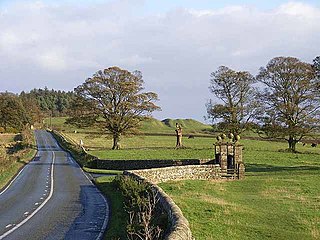
Hunnum was a Roman fort north of the modern-day village of Halton, Northumberland in North East England. The Latinized Brittonic name “Onnum” may mean "Stream/Water", "Ash (tree)", or “Rock”; if it means "Stream", it may be a reference to the Fence Burn, where a stream touches the line of Hadrian's Wall, but if it means "Rock", it may refer to Down Hill situated to the east of it. It was the fifth fort on Hadrian's Wall, after Segedunum (Wallsend), Pons Aelius (Newcastle), Condercum and Vindobala. It is situated about seven and a half miles west of Vindobala, and is two and a half miles north of Corstopitum. The site of the fort is bisected by the B6318 Military Road, which runs along the route of the wall at that point.

Bewcastle Roman Fort was a Roman fort, built to the north of Hadrian's Wall as an outpost fort and intended for scouting and intelligence. The Roman name for the fort was Fanum Cocidi, and means 'The Shrine of Cocidius', a deity worshipped in northern Britain. The remains of the fort are situated at the village of Bewcastle, Cumbria, 7 miles (11 km) to the north of the Roman fort at Birdoswald, on Hadrian's Wall.
Jebiniana is a town and commune in the Sfax Governorate, Tunisia.

Honaine is a town and commune in Tlemcen Province in northwestern Algeria.

Roman Rock Lighthouse is a lighthouse in False Bay, near Simon's Town. It is the only lighthouse in South Africa built on a single rock.

Mahjouba, Tunisia is a place in the Sahel, Tunisia regionof North Africa 54 km from Carthage. It is near Mateur and is the site of a fault line
Lydae or Lydai was a town of ancient Caria or Lycia. Ptolemy notes the city in Lycia under the name Chydae. The Stadiasmus Maris Magni calls the city Clydae or Klydai (Κλυδαί) and places it in Caria. The family of Gaius Iulius Heliodoros from Lydae, which produced Lycian Federal Priests, an archiphylax, and a Roman Senator, is well-documented. The demoi of Lydae, Arymaxa and Kreneis are known in Roman imperial times; they used to be separate communities that merged with Lydae via sympoliteia.

















